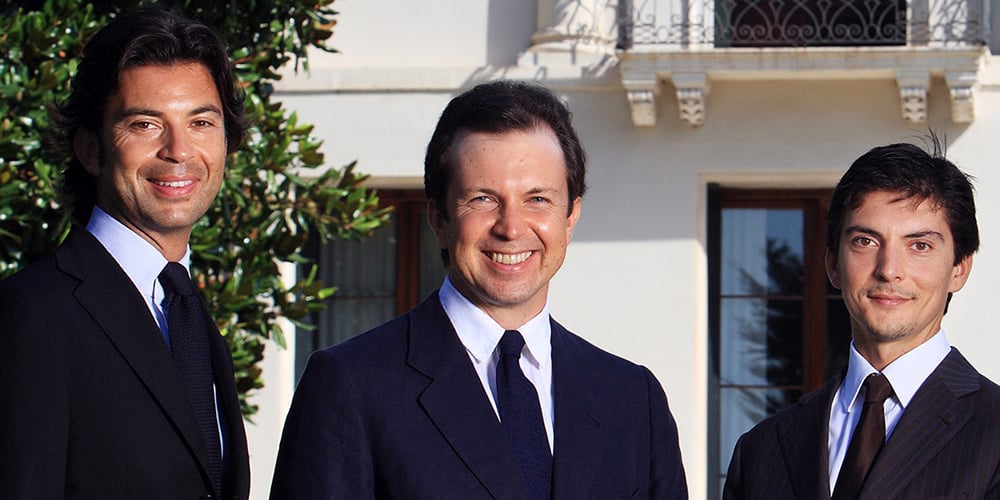Domenico Zonin, together with the other members of his large family, has played a dynamic role in the important leap in quality which has placed the various proprietary estates of the house in the forefront of the many zones in which they operate. The first move outside the original base in the Italian northeast took place in the late 1970’s with the acquisition of Castello d’Albola in Tuscany’s Radda in Chianti. A move which showed much foresight indeed: at the time the property was considered too high in altitude to properly ripen Sangiovese grapes. But the new, quality-oriented viticultural techniques which were adopted, together with the more recent warming due to the climate change of the new millennia, has demonstrated in an unmistakable fashion just how intelligent and far-sighted this purchase was. An equal stir was created by the move into Sicily in 1997 at a moment when, unlike today, only a small part of the island’s production left Sicily in the form of a bottle; the favorite form of marketing was the tanker truck. That decision of the part of this northern Italian house has been followed by many a competitor over the past fifteen years, but it was Zonin which set off the rush. In this conversation, Domenico Zonin describes both the origins of the project and the developments of the past decade.
T. I know you were young at the time, but the facts and the details have surely been told to you on various occasions. Without asking you to reveal classified information, can you tell us something about the decision came to be made?
Z. They are, just as you said, secrets, but ones which pertain to the house, not state secrets, accordingly I shall gladly tell you what I know. The overall technical supervision of our work at the time had been entrusted to Franco Giacosa, originally from Piedmont but for many years in charge of winemaking at the Duca di Salaparuta firm in Casteldaccia near Palermo.
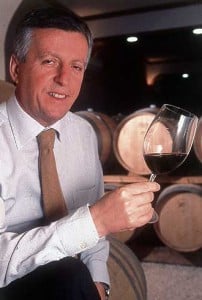
Franco Giacosa
(Giacosa is a classical name from around the city of Alba and when, during conventions, congresses, or meetings, he introduced himself “Giacosa, Palermo” he attracted stares which seemed to say “are you kidding me?”). Duca di Salaparuta, at the time, belonged to the regional government of Sicily, and the grapes it needed for its work were principally purchased in the various viticultural areas of the island. Franco, consequently, had an incomparable knowledge, almost yard by yard, of the of the zones, the grapes, and the choice spots, and when the decision to look for an important Sicilian property began to take on a concrete form in 1996-1997, he played a key role in the choice of the place to invest in. He was very enthusiastic about Butera in the province of Caltanissetta, and given that the policy of Zonin has always been to give a central place in the line to native Italian grapes, the fact that Franco was quite convinced of the quality level of the Nero d’Avola of this zone, made the choice fall precisely on this spot. A decision which was right on target, I feel free to say, at the current moment we have close to 175 acres (70 hectares) of vineyards planted to Nero d’Avola and our annual production of the wine is over 200,00 bottles.
T. Can you give us a brief description of the estate, even if we know that it is a sizeable one and it might be difficult to summarize everything in a few words?
Z. I’ll do my best, and I shall say right away that, yes, there are obviously differences between sub-zone and sub-zone within the confines of the property, but not of an order which would lead to enormous differences in the viticulture or winemaking. We are in the province of Caltanissetta, but compared to the city of Caltanissetta we are significantly further to the south, some 30 miles (50 kilometers to be precise). 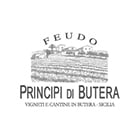 A distance which corresponds to a notably lower altitude, the city is at more than 1750 feet (570 meters) above sea level, while the vineyards are between 1000 and 1150 feet (300-350 meters) in altitude. A difference which means a greater warmth, even if at this altitude the evenings and nights are substantially cooler than the days with all of the well known advantages which these temperature swings almost always bring. In additional, we are relatively close to the sea, there are just over 15 miles between Butera and Femmina Morta directly south on the Mediterranean, and the maritime influence gives us a breeziness and additional solar radiation which are equally beneficial.
A distance which corresponds to a notably lower altitude, the city is at more than 1750 feet (570 meters) above sea level, while the vineyards are between 1000 and 1150 feet (300-350 meters) in altitude. A difference which means a greater warmth, even if at this altitude the evenings and nights are substantially cooler than the days with all of the well known advantages which these temperature swings almost always bring. In additional, we are relatively close to the sea, there are just over 15 miles between Butera and Femmina Morta directly south on the Mediterranean, and the maritime influence gives us a breeziness and additional solar radiation which are equally beneficial.
Within the confines of the estate, in addition to the altitude differences, there are differences of soil as well, the higher parts of the property are also calcareous and, as is normally the case, these soils tend to limit production and maintain the acidity well, the latter something obviously useful in an area which tends to be rather warm. These are the zones which we have preferred for the red grape varieties, while the lower-laying and more fertile areas tend – I shall repeat the word – to be reserved for the white grapes.
T. What type of viticulture did you find when you arrived?
Z. No type at all, the agriculture consisted of grain fields, there were alsosheep, but that was it. We had to do everything on our own, starting from scratch even if history and tradition indicated that this was a spot for Nero d’Avola and Insolia.
T. How did you plant the vineyards during the initial phase of operations?
Z. Nothing particularly unusual or exotic, I don’t consider it necessary seeing as we are not looking to produce a great deal of wine, therefore no overhead training systems, the vineyards are planted to either Guyot or cordon de Royat and the spacing gives us 1800-2000 vines per acre (4500-5000 per hectare), more than sufficient for the local climate, high densities and very limited production per vine would make no sense in a Mediterranean climate of this type. For the white wines, in any case, the production is 2.2 pounds (one kilogram) of grapes per vine, the quantity which we consider proper for the quality which we aim to achieve.
T. Have there been changes in the varieties in the range compared to those which were offered at the beginning o f the new millennium?
Z. Some things have changed but nothing fundamental, the basis of the line is, and will remain, Insolia and Nero d’Avola which, together, represent approximately 450,000 bottles of varietal wines. If we add the selections and the blend of Nero d’Avola and Syrah, the total is 550,000 bottles, by far the largest part of the line. In the case of the white wines, we have eliminated Catarratto and added Grillo whose vineyard acres, both here in this zone and elsewhere on the island, will certainly grow. As far as non-traditional grapes are concerned, we planted Chardonnay, Merlot, and Cabernet Sauvignon, something which was in the air in the 1990’s, a decision which we do not regret, on the contrary we are satisfied with the results, but the only non-traditional grape which seems to give us wines of a greater complexity and prestige is Syrah, which has shown an interesting affinity to the soil and climate of Sicily. The “war” between native and international grapes has always struck me as sort of absurd Manichaeism, a sort of sectarian battle in the context of a market economy. We have both local grapes and international varieties in Sicily just as we have both Vermentino and Nebbiolo in Virginia alongside Cabernet and Merlot, what’s the problem?
T. Are your more recent Sicilian wines different in aroma and flavor from those you presented at the end of the 1990’s and the early years of the new millennium, have you changed the style?
Z. I wouldn’t speak so much of change as of evolution, you have to remember that the first wines were produced from very young vineyards, planted just after the purchase; today’s grapes, from vines with now close to 20 years of age, are obviously quite different from those of the initial period. Even if the winemaking of that early period had a certain familiarity with Nero d’Avola and Isolia as grape varieties , what you can do with the grapes of a vine of a certain age you cannot do with a vine in its first years of life and production. Not to speak of the fact that the concept of “zone” tells you something but certainly does not tell you everything, just as everyone else we have certain differences between one vineyard parcel and another, and Butera, like every other township, fortunately does not produce and cannot produce grapes which are homogeneous in character and quality in every single vineyards.
In addition, Sicily, in the 1990’s did not produce much bottled wine, models – not ones to follow in slavish fashion but perhaps capable of suggesting and inspiring – did not exist, we had to create our own style, one which aimed not only at proposing our idea of wine but at doing it in a context which was very different indeed from that of today. At the time there were many preconceptions about Sicily and the wines it could and should express – accordingly, as I have said, the wines of today are the product of an evolutionary process during which we have learned a great deal. We have succeeded in offering wines which, at the same time, are decisively Sicilian but with an elegance and balance which few believed we could achieve when we began twenty years ago. Rome was not built in a day, and trying to work at a forced pace is always mistaken, viticulture has its own rhythms which are not those of an industrial process.
T. Can you describe the changes which were made during this evolutionary process?
Z. If we are talking about changes in the wines, a good part is due to the fact that the grapes themselves, thanks to the age of the vines, are already richer and endowed with a patrimony of aromas and flavors of greater complexity, therefore there is no need to force extraction during the fermentations, a practice which in any case we have never believed in. The extraction is carried out principally by pumping over the cap of skins in the tank supplemented by occasional punching down of the cap and delestage, the period of skin contact has been prolonged in the case of the red wines and can last as long as thirty days in the case of the most important wines.
The Insolia selection, Il Serbo, unlike the regular Insolia bottling, is a blend of wine aged in stainless steel tanks and, another smaller part, aged in oak casks, which add an additional complexity which both we and our clientele much appreciate. They are casks, not barrels, an important difference. Our Chardonnay, which formerly was partly aged in barrel, now sees only stainless steel.
As far as the red wines, by far the largest part of the production, 70%, we distinguish between native and International varieties. The Nero d’Avola is aged exclusively in oak casks, there is no use whatsoever of smaller formats, not even a puncheon, while the Syrah is aged both in cask and barrel; the percentages vary from year to year, good wine cannot be made either with formulas or, above all, dogmas and preconceived theories.
T. You were among the first in Italy to avail yourself of the counsels and contributions of Denis Dubourdieu of the Univesity of Bordeaux. Can you tell us something about this collaboration?
Z. Dubourdieu, who unfortunately passed away last autumn, was of the greatest possible aid and assistance to our family and not only to us, I do not hesitate to say so. He had an enormous respect for Italy and its viticulture and made important contributions to its improvement – a man of great curiosity and culture, he certainly did not come to Italy to produce solely Chardonnay, Cabernet, and Merlot, he very much liked our grapes and gave his utmost to bringing out all of their quality and character.
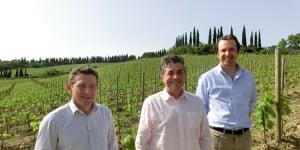
Da sinistra: Christophe Ollivier, Denis Dubourdieu e Domenico Zonin al Castello di Albola
We already spoke about the oenological aspects of the changes we undertook over the past fifteen years, and the lengthening of the period of skin contact for the major wines was only one of his many suggestions.
In Italy, we often have the idea that viticulture and oenology move along parallel tracks which do not cross and meet, but in the case of this consultant they were one single whole, we are talking about the son of a producer of Sauternes and a producer himself of both red and white wine at Château Reynon and Château Floridène. He was an expert viticulturist as a direct cultivator of vineyards and his ideas were as valid in this field as were those in the cellar. Thanks to his counsels we changed many aspects of our cultivation practices. First and foremost, phases such as leaf-removal and crop-thinning which might appear to be simple operations but in fact are nothing of the sort. Ok, leaves need to be eliminated but at what point in the growing season, how many and which ones, removing the leaf on top of the bunch is not the same as removing another below it. Same story for crop-thinning: you need a good eye, and much knowledge and experience, a pair of scissors is by no means enough. I will add at this point that our own staff consists of high level professionals, both our supervisor Stefano Ferrante and the winemaker at Principe di Butera, Antonio Paolo Froio. Just as, I might add parenthetically, Alessandro Gallo at Castello di Albola in Radda in Chianti. We are not xenophiles in any sort of exaggerated way, but it would be ridiculous not to take advantage of the knowledge and experience of men and women who work all over the world, by now we are all part of an interlocking international market for quality wine and excesses of either cosmopolitanism or provincialism would be equally mistaken and limiting as approaches.
T. Conclusions? Perspectives?
Z. In the world of wine there are never conclusions, the work must go forward with the aim of constant quality improvement, at the moment, although we are satisfied with our Syrah, we are talking to an Australian winemaker who also produces his own Syrah wine with the obvious idea of trying new concepts and practices in the vineyard and the cellar which will lead to a further jump in the level of the Syrah. As far as new wines are concerned, we have planted Nerello Mascalese at Butera, we are somewhat far from the classic areas for the cultivation of this grape but we shall see, to be blocked by preconceptions and prejudices is not part of the way we work, after all our Rocca di Montemassi estate on the Tuscan coast is located in an area where, historically, there were few vineyards and little production of wine. 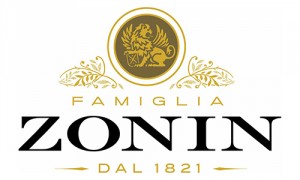 Despite this fact, many have invested in this part of the province of Grosseto, and the wines which we have succeeded in creating – and I am not talking merely about our own – are well thought of. After all, no one is going to force us a bottle a wine we do not believe in. Up until now, Sicily has never disappointed us, and has been – I shall allow myself to say so – a great success as well. Our original base was in northern Italy and the first investments outside of this area were in Tuscany, we had never gone any further south. Principe di Butera, therefore, was an important bet and a true challenge which, over the years, has given us so much satisfaction that we have also invested in an important project in the Brindisi area of Puglia. As Machiavelli observed, fortune is a woman and favors the daring, we are entrepreneurs and risk is part of our work but the capital poured into Sicily has returned to us with abundant gains over the course of the years.
Despite this fact, many have invested in this part of the province of Grosseto, and the wines which we have succeeded in creating – and I am not talking merely about our own – are well thought of. After all, no one is going to force us a bottle a wine we do not believe in. Up until now, Sicily has never disappointed us, and has been – I shall allow myself to say so – a great success as well. Our original base was in northern Italy and the first investments outside of this area were in Tuscany, we had never gone any further south. Principe di Butera, therefore, was an important bet and a true challenge which, over the years, has given us so much satisfaction that we have also invested in an important project in the Brindisi area of Puglia. As Machiavelli observed, fortune is a woman and favors the daring, we are entrepreneurs and risk is part of our work but the capital poured into Sicily has returned to us with abundant gains over the course of the years.


